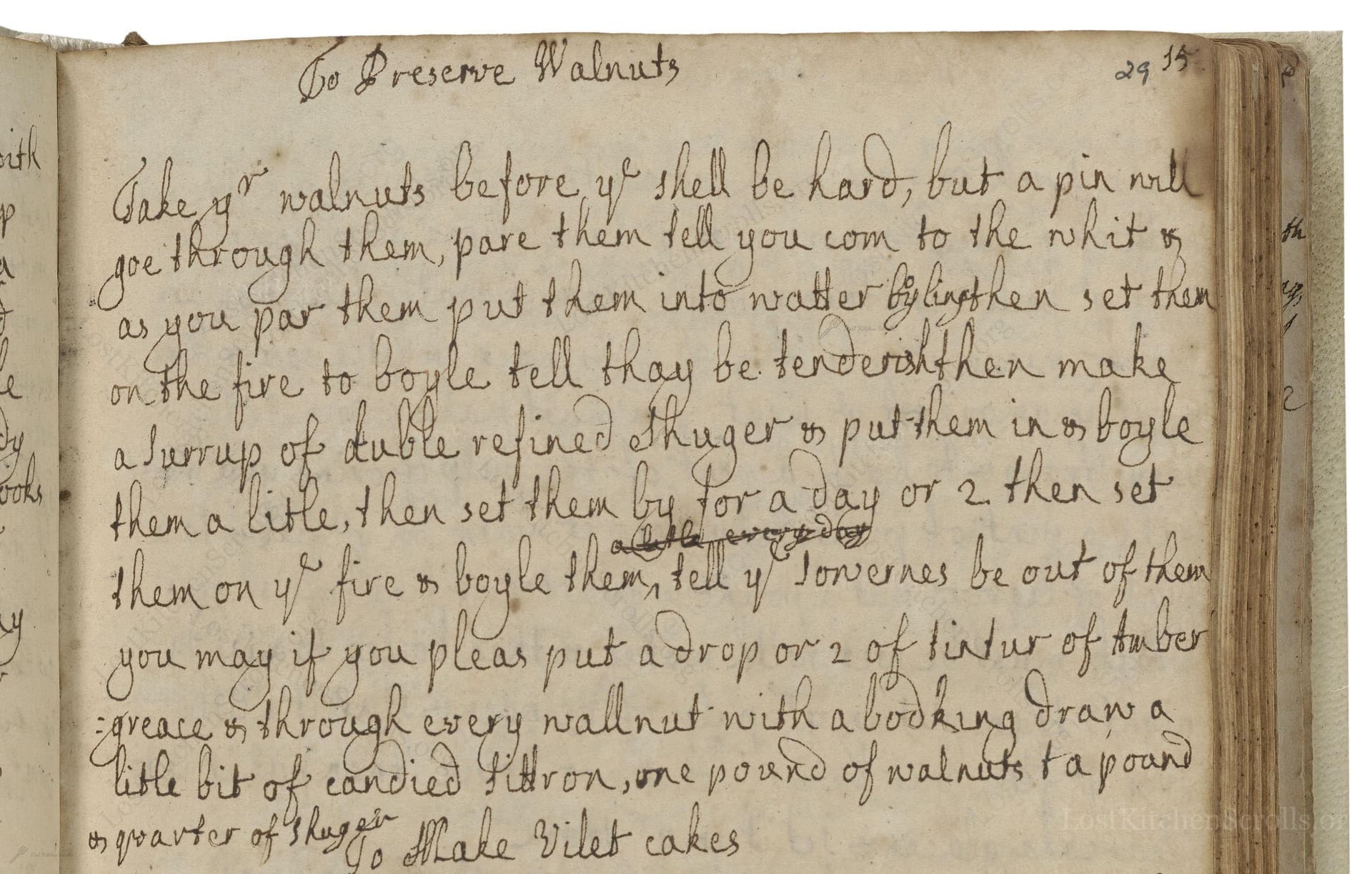To Preserve Walnuts
From the treasured pages of Cook-book of Margaret Turner
Written by Margaret Eyre

To Preserve Walnuts
"Take yr walnuts before ye shells be hard, but a pin will goe through them, pare them tell you com to the whit as you par them put them into watter byling then set them on the fire to boyle tell thay be tenderish then make a surrup of duble refined shuger & put them in & boyle them a litle, then set them by for a day or 2 then set them on yr fire & boyle them, tell yr sowernes be out of them you may if you pleas put a drop or 2 of tintur of amber greace & through every wallnut with a bodking draw a litle bit of candied sittron, one pound of walnuts to a pound & a quarter of shuger"
Note on the Original Text
The original recipe uses a flowing, conversational style—typical of early modern manuscripts—with minimal punctuation and inconsistent spelling ('boyle tell thay be tenderish'). Quantities are often proportional and approximate, suited to cooks experienced at judging by eye and taste rather than exact measures. Words like 'pare' mean to peel, and 'surrup' is syrup. The recipe places trust in the cook’s own knowledge for such tasks as boiling 'tell your sowernes be out of them', leaving timing to taste and experience.

Title
Cook-book of Margaret Turner (1709)
You can also click the book image above to peruse the original tome
Writer
Margaret Eyre
Era
1709
Publisher
Unknown
Background
Step into the refined world of early 18th-century cookery with Margaret Eyre, where recipes are whispered secrets and culinary wonders await. From hearty roasts to delicate sweets, this charming tome serves up inspiration fit for the tables of historic England.
Kindly made available by
Folger Shakespeare Library
This recipe comes from the early 18th-century recipe collection of Margaret Eyre, dating to around 1709. The practice of preserving green walnuts was popular in both English and continental kitchens. Such preserves were considered luxurious, as walnuts and refined sugar were both costly and signified a household with means. Ambergris, a rare and aromatic substance derived from sperm whales, was a prized and fashionable flavoring in high-status kitchens, though today it's often replaced with vanilla or citrus notes for similar aromatic floral complexity.

Historical cooks would have used a brass or copper preserving pan over an open fire or hearth for boiling. A sharp small knife and bodkin (a pointed skewer or needle) would be employed to peel and pierce the walnuts, and to thread the citron. Fine sieves and porcelain or earthenware bowls were used for holding and cooling the fruit, and glass jars or stoneware pots for final storage of the preserve.
Prep Time
45 mins
Cook Time
1 hr
Servings
30
We've done our best to adapt this historical recipe for modern kitchens, but some details may still need refinement. We warmly welcome feedback from fellow cooks and culinary historians — your insights support the entire community!
Ingredients
- 2.2 lbs young green walnuts (harvested before shells harden)
- 2.75 lbs white granulated sugar (to substitute 'double refined sugar')
- Water (enough to cover walnuts; for syrup, just enough to dissolve sugar)
- A few drops ambergris tincture (or substitute with 1/2 tsp vanilla extract)
- 3.5 oz candied citron, cut into thin slivers
Instructions
- Begin by selecting young, green walnuts, picking them while the shells are still soft enough to easily pierce with a needle.
- Peel off the outer skins gently until you reach the pale flesh beneath.
- As you prepare each walnut, place them into boiling water to prevent discoloration.
- Once all are prepared, simmer the walnuts until they are just tender.
- Meanwhile, prepare a sugar syrup using 2.75 lbs of double refined sugar for every 2.2 lbs of walnuts.
- Add enough water to just cover the sugar and heat until dissolved.
- Add the drained, boiled walnuts and bring briefly to a simmer.
- Remove from heat and let the walnuts sit in the syrup for a day or two.
- After this resting period, bring the walnuts and syrup back to a gentle boil and cook until the 'sourness' or vegetal sharpness of the walnuts has dissipated.
- If you wish, add a drop or two of ambergris tincture (or, as a modern substitute, use vanilla extract for aroma).
- For an elegant finishing touch, thread a sliver of candied citron through each walnut.
- Store the preserved walnuts in sterilized jars.
Estimated Calories
100 per serving
Cooking Estimates
Peeling and preparing the walnuts takes time, as does both rounds of simmering and multiple resting periods. You’ll spend about 45 minutes preparing the walnuts, about 1 hour in total for cooking and simmering, and an additional 24 hours resting in syrup. Each walnut is sweet and rich due to the sugar, so the calorie estimate is for a single walnut. This recipe makes around 30 preserved walnuts.
As noted above, we have made our best effort to translate and adapt this historical recipe for modern kitchens, taking into account ingredients nowadays, cooking techniques, measurements, and so on. However, historical recipes often contain assumptions that require interpretation.
We'd love for anyone to help improve these adaptations. Community contributions are highly welcome. If you have suggestions, corrections, or cooking tips based on your experience with this recipe, please share them below.
Join the Discussion
Rate This Recipe
Dietary Preference
Main Ingredients
Culinary Technique

Den Bockfisch In Einer Fleisch Suppen Zu Kochen
This recipe hails from a German manuscript cookbook compiled in 1696, a time whe...

Die Grieß Nudlen Zumachen
This recipe comes from a rather mysterious manuscript cookbook, penned anonymous...

Ein Boudain
This recipe comes from an anonymous German-language manuscript cookbook from 169...

Ein Gesaltzen Citroni
This recipe, dating from 1696, comes from an extensive anonymous German cookbook...
Browse our complete collection of time-honored recipes



